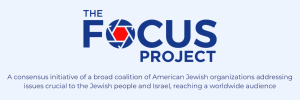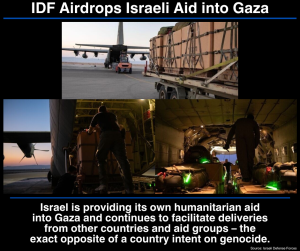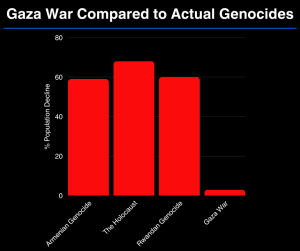
July 29, 2025
STAY INFORMED – TALKING POINTS – ACTIONS TO CONSIDER – STORIES MAKING NEWS
![]()

Humanitarian Aid: The Complex and Tragic Toll of the Hamas War
Civilians in Gaza are suffering – caught in the middle of a brutal war – with hundreds of thousands displaced, infrastructure decimated and widespread food insecurity. Israel recently announced a military pause in Gaza to allow for an expanded distribution of humanitarian aid for up to 10 hours daily. President Trump also announced a new U.S.-European partnership to open unguarded food distribution centers inside Gaza, marking a notable expansion of direct relief efforts. Neighboring partners – including Jordan, Egypt and the UAE – have joined airdrop missions, delivering critical food supplies.
While much of the world holds Israel responsible for alleviating Gaza’s crisis, it is important to remember that it was Hamas that invaded Israel on Oct. 7, killing more than 1,200 and dragging hostages into Gaza, sparking this horrific war.
As stated by its own leaders, Hamas is willing to sacrifice its people to destroy the Jewish state. While aid has been delivered on multiple occasions since the war began, Hamas and criminal gangs in Gaza have been known to steal aid, hoard fuel and execute civilians who challenge their control. Hamas continues to reject ceasefire proposals – including the most recent offer brokered by the U.S. and its partners, refuses to release Israeli hostages and demands to remain in power at the expense of its own citizens.
Getting aid into Gaza is not just an Israeli problem. Egypt controls a key border crossing that it has largely kept shut – and the country built a massive wall in early 2024 to protect its border with Gaza. The United Nations has left hundreds of aid trucks undelivered inside Gaza claiming security risks. The vast majority of Arab countries have not directly contributed to relief efforts in Gaza. Meanwhile, Israel while facing a multi-front war with Iranian terrorist proxies – including Hezbollah and the Houthis – has been expected to fight Hamas, oversee all aid into Gaza and minimize civilian casualties all at the same time.
The suffering in Gaza is heartbreaking, Israel has taken extensive measures to prevent humanitarian collapse at its own risk, while fighting a terror group that embeds itself among civilians and refuses to surrender. Israel has expanded humanitarian corridors, opened new entry points and coordinated with the U.S. and other partners to facilitate relief. In recent months, the Israel-U.S.-backed Gaza Humanitarian Foundation (GHF) has delivered nearly 100 million meals, feeding up to two million Gazans a day while bypassing Hamas control. Israel also has facilitated entry of 94,000 aid trucks carrying more than 1.8 million tons of food, fuel and medical supplies. The Israeli Defense Forces recently airdropped Israeli aid into Gaza for the first time.

Prime Minister Netanyahu and other officials have emphasized that dismantling Iran-backed Hamas must go hand-in-hand with avoiding a humanitarian collapse. John Spencer, chair of urban warfare studies at West Point: “I have seen restraint by the IDF in Gaza, humanitarian aid and deliberate compliance with legal standards, often at tactical cost.” Providing aid to a civilian population on the other side in a war is virtually unprecedented. Despite these extraordinary efforts, headlines continue to portray Israel as deliberately starving Gaza.
Deflection and Misinformation Prolong the Crisis
The humanitarian crisis in Gaza is real and horrifying, with shortages of food, medical supplies and drinkable water fueling immense civilian suffering. Images and reports of devastation have shocked the world. But as former IDF international spokesperson and current senior fellow at the Foundation for Defense of Democracies, Jonathan Conricus, explained, this crisis is not merely a byproduct of war – it is rooted in Hamas’s deliberate strategy of leveraging human suffering to pressure Israel politically and diplomatically. Hamas has rejected ceasefires, hoarded aid and uses civilians as shields, all while continuously vowing to annihilate Israel and refusing to release Israeli hostages.
Hamas also is weaponizing images and media coverage to amplify outrage. While many of the images are authentic, some widely circulated photos have been proven misleading or misused. One recent viral image of an emaciated child actually depicted a five‑year‑old boy evacuated with Israel’s help on June 12 to Italy for treatment of a genetic illness unrelated to the war.
Another viral image, according to an investigative reporter, featured by multiple media outlets and shared repeatedly on social media appears to be of a boy with cerebral palsy requiring specialized medical care since birth. As tragic as these children’s stories are, Hamas’s use of their images to elicit global outrage only confirms their lack of respect for the lives of its own citizens and willingness to do anything to retain control of Gaza at all costs.
False narratives inflame outrage, fuel attacks against Jews and harden public opinion against Israel around the world – exactly as Hamas intends. The ecosystem of misinformation – from viral “citizen journalists” to AI deepfakes – makes truth harder to discern. Combatting misinformation requires skepticism, reverse image searches and following analysts who report from verified sources.
Debunking the ‘Genocide’ Accusation: ‘Psychological warfare’
The most explosive charge leveled against Israel is genocide – a term that evokes the Holocaust – and that is no accident. Hamas and its advocates deliberately use this framing to falsely cast Israel as a uniquely evil state deserving annihilation.
The facts tell a different story. Genocide, under international law, requires the intent to destroy an entire group. Israel’s actions demonstrate the opposite upon closer inspection: while waging war against a genocidal terrorist organization – Hamas – has facilitated humanitarian aid, issued evacuation warnings before strikes and taken unprecedented steps to minimize civilian harm.
Genocides are marked by catastrophic population loss. The Nazi Holocaust of 6 million Jews, the Hutu genocide of 600,000 Tutsis in only 100 days in Rwanda and the more than 1 million Armenians massacred by the Ottoman Turks. At least 60% of the population was murdered in these actual genocides. Even if Hamas’s inflated casualty figures are accepted, less than 3% of Gazans have died, and a large portion were Hamas militants.

Reports from NGOs and independent military experts confirm that Israel’s casualty ratios – while devastating in human terms – remain significantly lower than comparable conflicts. The reality is not a genocide. This ongoing conflict is an ugly, asymmetrical war against a terrorist group that pledges to repeat Oct. 7 “again and again” while hiding behind its own people. Hamas uses hospitals, schools, and mosques as weapons depots, ensuring any Israeli response risks civilian casualties. As former U.S. Sec. of State Antony Blinken warned, international outrage aimed solely at Israel rewards Hamas for its intransigence, prolonging both the war and civilian suffering.
Political psychologist Dr. Irwin Mansdorf calls shifting of blame and the exploitation of images “psychological warfare.” This strategy manipulates public opinion and transfers the moral burden from Hamas to Israel. France’s recent announcement that it will recognize a Palestinian state at the UN in September – condemned by U.S. Jewish groups as “dishonoring Oct. 7 victims” – demonstrates how Hamas turns outrage into powerful political gains.
Since Oct. 7, Hamas has always had the option to end its people’s suffering by surrendering and releasing the hostages, but has consistently refused the option to achieve peace.
![]()

![]()

Fighting Propaganda and Psychological Warfare
Want to push back against Hamas’s manipulation and misinformation campaigns? Start here:
How To Do a Reverse Image Search (No Tech Skills Required)
![]()

Tisha B’Av 5785: Still, We Rise
William Daroff is CEO of the Conference of Presidents of Major American Jewish Organizations – the senior professional guiding the Conference’s agenda on behalf of 50 national member organizations, which represent the wide mosaic of American Jewish life.
We fast. We mourn.
We sit low to the ground and dwell in the dust of our people’s tragedies, reciting the litany of loss that has shaped the Jewish story: Zion’s toppled towers; Jerusalem, once great among the nations, brought low; the expulsions from Sepharad and the Rhineland; our decimation in the Holocaust.
It is a day not only of memory, but of reckoning. A day when we allow ourselves to feel the full weight of Jewish history pressing down upon us. And this year, that weight feels heavier still.
We enter Tisha B’Av 5785 still reeling from the trauma of Oct. 7, the most brutal slaughter of Jews in a single day since the Holocaust. Families torn apart. Children and grandparents dragged into Gaza. Whole communities erased. The pain is raw, the grief ongoing, the hostages still not home. Fifty souls remain in the clutches of Hamas – dead or alive – languishing in terror’s dungeons.
We mark this day amid a global wave of antisemitism, where our dead are met with indifference, our students with intimidation, our people with vilification. In city squares and on college campuses, hatred once whispered now marches and shouts.
And yet, Tisha B’Av is not only about what has been destroyed; it is also about the spark that endures. Amid the dust, it reminds us that even the most shattered vessel can be mended. That out of desolation, renewal is possible. That Am Yisrael Chai. “The People of Israel live.”
Click here to read the full essay.
![]()

The Erasure of Jews: Targeted for How They Look, Speak or Pray
Recent attacks across the country and around the world reveal a frightening and growing trend: Jews – and even those mistaken for Jews – are being harassed, assaulted or excluded simply for looking Jewish, speaking Hebrew or visiting Jewish sites. These are not acts of political protest, but a campaign of intimidation aimed at erasing Jewish presence in public spaces.
Recent incidents:
Across Europe, Australia and America, Jews report hiding visible markers of identity and increasing security. These are not isolated incidents. This is a broader, deeply troubling effort to push Jews out of public life worldwide and punish them for the perceived actions of the Israeli government.
Stories Impacting American Jews
Stories Impacting the U.S. and Israel
Stories From Around the World
Stay Informed | Speak Up | Take Action
Want to Read More of Our Talking Points? Did you miss a recent edition of The Focus Project? No need to search your inbox. Our most recently published editions are available on our website.
![]()

This content is developed by The Focus Project in partnership with MERCAZ USA. The Focus Project distributes weekly news and talking points on timely issues concerning Israel and the Jewish people, including antisemitism, anti-Zionism and the delegitimization of Israel. It represents a consensus view across a spectrum of major American Jewish organizations. MERCAZ USA recognizes and respects the diversity of views on these issues among its readers and the community at large.